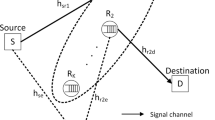Abstract
It has been verified that cooperative communication technology is an effective way to achieve physical layer security. Recently, people paid much attention to the cooperative networks with buffering relay, which can get a significant performance advantage. In this paper, we investigate the secure problem in decode-and-forward buffer-aided cooperative networks. Based on modified Max-ratio relay selection criteria, artificial noise is transmitted by the source when the selected buffering relay decode and forward message to the destination. The numerical simulation results demonstrate that our proposed Max-ratio with artificial noise (Max-ratio-AN for short) not only outperforms previously reported no-buffer-aided cooperative secure schemes by providing a significant coding gain for small buffer sizes but also ensures a diversity gain enhancement. Comparing to the existing Max-ratio scheme, it also can offer higher secure performance with appropriate artificial noise added.
Access this chapter
Tax calculation will be finalised at checkout
Purchases are for personal use only
Similar content being viewed by others
Notes
- 1.
Here, perfect synchronization is assumed between Alice and relays. In fact, the synchronization can be easily guaranteed, for example, when Alice has no information data to transmit, she can emit the artificial noise to guarantee the timely jamming confusion for Eve.
- 2.
T-DFbORS is the abbreviation of the traditional DF-based optimal relay selection scheme, it does not consider the wiretap link’s channel state information (CSI) and only maximizes the main channel’s SNR.
- 3.
P-DFbORS is the abbreviation of the proposed DF-based optimal relay selection scheme [19], it chooses the optimal relay that maximizes the secrecy capacity of DF relaying transmission.
- 4.
The theoretic performance bound is an important research work in the future.
- 5.
Secrecy diversity order determines the slope of the asymptotic outage probability curve [19]. The bigger the value, the outage probability declines more quickly as SNR.
References
Mukherjee, A., Fakoorian, S., Huang, J., Swindlehurst, A.: Principles of physical layer security in multiuser wireless networks: a survey. IEEE Commun. Surv. Tutor. 16(3), 1550–1573 (2014)
Liu, Y., Chen, H.-H., Wang, L.: Physical layer security for next generation wireless networks: theories, technologies, and challenges. IEEE Commun. Surv. Tutor. 19(1), 347–376 (2017)
Wyner, A.D.: The wire-tap channel. Bell Syst. Tech. J. 54(8), 1355–1387 (1975)
Bassily, R., Ekrem, E., He, X., Tekin, E., et al.: Cooperative security at the physical layer-A summary of recent advances. IEEE Signal Process Mag. 30(5), 16–28 (2013)
Hong, Y.W.P., Pang-Chang, L., Kuo, C.C.J.: Enhancing physical-layer secrecy in multiantenna wireless systems: an overview of signal processing approaches. IEEE Signal Process Mag. 30(5), 29–40 (2013)
Harrison, W.K., Almeida, J., Bloch, M.R., McLaughlin, S.W., Barros, J.: Coding for secrecy: an overview of error-control coding techniques for physical-layer security. IEEE Signal Process Mag. 30(5), 41–50 (2013)
Chen, X., Ng, D.W.K., Gerstacker, W.H., Chen, H.H.: A survey on multiple-antenna techniques for physical layer security. IEEE Commun. Surv. Tutor. 19(2), 1027–1053 (2017)
Zlatanov, N., Ikhlef, A., Islam, T., Schober, R.: Buffer-aided cooperative communications: opportunities and challenges. IEEE Commun. Mag. 52(4), 146–153 (2014)
Bing, X., Yijia, F., Thompson, J., Poor, H.V.: Buffering in a three-node relay network. IEEE Trans. Wirel. Commun. 7(11), 4492–4496 (2008)
Ikhlef, A., Michalopoulos, D.S., Schober, R.: Max-max relay selection for relays with buffers. IEEE Trans. Wirel. Commun. 11(3), 1124–1135 (2012)
Lianghui, D., Meixia, T., Fan, Y., Wenjun, Z.: Joint scheduling and relay selection in one- and two-way relay networks with buffering. In: IEEE International Conference on Communications, ICC 2009, Dresden, Germany, pp. 1–5 (2009)
Krikidis, I., Charalambous, T., Thompson, J.S.: Buffer-aided relay selection for cooperative diversity systems without delay constraints. IEEE Trans. Wirel. Commun. 11(5), 1957–1967 (2012)
Raza, W., Javaid, N., Nasir, H., Alrajeh, N., Guizani, N.: Buffer-aided relay selection with equal-weight links in cooperative wireless networks. IEEE Commun. Lett. 22(1), 133–136 (2018)
Nomikos, N., Charalambous, T., Krikidis, I., Skoutas, D.N., Vouyioukas, D., Johansson, M., et al.: A survey on buffer-aided relay selection. IEEE Commun. Surv. Tutor. 18(2), 1073–1097 (2016)
Qiao, D.Q., Gursoy, M.C.: Buffer-aided relay systems under delay constraints: potentials and challenges. IEEE Commun. Mag. 55(9), 168–174 (2017)
Jing, H., Swindlehurst, A.L.: Wireless physical layer security enhancement with buffer-aided relaying. In: Asilomar Conference on Signals, Systems and Computers, ACSSC 2013, pp. 1560–1564. CA, USA (2013)
Huang, J., Swindlehurst, A.L.: Buffer-aided relaying for two-hop secure communication. IEEE Trans. Wirel. Commun. 14(1), 152–164 (2015)
Gaojie, C., Zhao, T., Yu, G., Zhi, C., Chambers, J.A.: Max-ratio relay selection in secure buffer-aided cooperative wireless networks. IEEE Trans. Inf. Forensics Secur. 9(4), 719–729 (2014)
Yulong, Z., Xianbin, W., Weiming, S.: Optimal relay selection for physical-layer security in cooperative wireless networks. IEEE J. Sel. Areas Commun. 31(10), 2099–2111 (2013)
Liao, X., Wu, Z.Y,Z., Shen, Y., Jiang, X., Inamura, H.: On security-delay trade-off in two-hop wireless networks with buffer-aided relay selection. IEEE Trans. Wirel. Commun. 17(3), 1893–1903 (2017)
Yajun, Z., Tao, L., Aiwei, S.: A New max-ratio relay selection scheme in secure buffer-aided cooperative wireless networks. Electron. Lett. (to be published)
Jiangyuan, L., Petropulu, A.P., Weber, S.: On cooperative relaying schemes for wireless physical layer security. IEEE Trans. Signal Process. 59(10), 4985–4997 (2011)
Acknowledgments
This research was supported by the National Nature Science Foundation of China under grant 61471392 and 41705042.
Author information
Authors and Affiliations
Corresponding author
Editor information
Editors and Affiliations
Rights and permissions
Copyright information
© 2019 Springer Nature Singapore Pte Ltd.
About this paper
Cite this paper
Zhang, Y., Wang, H., Shi, W. (2019). Improving Physical Layer Security Using Artificial Noise for Buffer-Aided Relay Networks. In: Liang, Q., Liu, X., Na, Z., Wang, W., Mu, J., Zhang, B. (eds) Communications, Signal Processing, and Systems. CSPS 2018. Lecture Notes in Electrical Engineering, vol 515. Springer, Singapore. https://doi.org/10.1007/978-981-13-6264-4_5
Download citation
DOI: https://doi.org/10.1007/978-981-13-6264-4_5
Published:
Publisher Name: Springer, Singapore
Print ISBN: 978-981-13-6263-7
Online ISBN: 978-981-13-6264-4
eBook Packages: EngineeringEngineering (R0)




